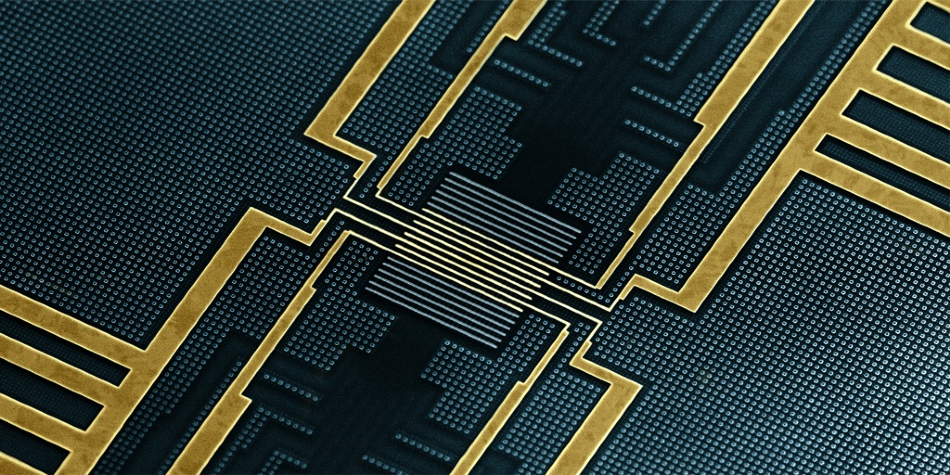Feb 20 2020
Scientists from ETH Zurich have quantified the timing of single writing events in an innovative magnetic memory device that has a resolution of <100 ps. The study outcomes are relevant for magnetism-based futuristic main memories.
 The chip produced by IMEC for the experiments at ETH. The tunnel junctions used to measure the timing of the magnetization reversal are located at the center. Image Credit: IMEC.
The chip produced by IMEC for the experiments at ETH. The tunnel junctions used to measure the timing of the magnetization reversal are located at the center. Image Credit: IMEC.
At ETH Zurich’s Department for Materials, Pietro Gambardella and his colleagues analyze next-generation memory devices. They should be fast, store data reliably for a long period, and also be inexpensive. The so-called magnetic “random access memories” (MRAM) realize this part of the circle by integrating rapid switching through electric currents with long-lasting data storage in magnetic materials.
A few years ago, scientists demonstrated that a specific physical effect—called the spin-orbit torque—renders specifically fast data storage viable. At present, in collaboration with the R&D-center IMEC in Belgium, Gambardella’s team has been able to temporally resolve the precise dynamics of a single such storage event, as weel as to make it much faster by using a few tricks.
Magnetizing with Single Spins
For magnetic storage of data, a ferromagnetic (that is, permanently magnetic) material’s direction of magnetization must be inverted to represent the information as a logic value, 0 or 1. In earlier technologies, such as hard drives or magnetic tapes, this is realized by magnetic fields generated within current-carrying coils.
On the contrary, modern MRAM-memories directly exploit the spins of electrons, which are magnetic, quite similar to small compass needles, and directly flow via a magnetic layer as an electric current. In the experiments performed by Gambardella, electrons that have opposite spin directions are spatially isolated by the spin-orbit interaction. This forms an effective magnetic field that can be used to invert the magnetization direction of a tiny metal dot.
We know from earlier experiments, in which we stroboscopically scanned a single magnetic metal dot with X-rays, that the magnetisation reversal happens very fast, in about a nanosecond. However, those were mean values averaged over many reversal events. Now we wanted to know how exactly a single such event takes place and to show that it can work on an industry-compatible magnetic memory device.
Eva Grimaldi, Post-doc and Researcher, Department for Materials, ETH Zurich
Time Resolution Through a Tunnel Junction
The researchers achieved this by replacing the separated metal dot by a magnetic tunnel junction. A tunnel junction such as this includes two magnetic layers isolated by an insulation layer with a thickness of just 1 nm. Based on the spin direction—along the magnetization of the magnetic layers, or in the direction opposite to it—the electrons can tunnel through that insulating layer almost easily.
This leads to an electrical resistance that relies on the alignment of the magnetization in one layer in relation to the other, thereby representing “0” and “1.” The researchers were able to reconstruct the precise dynamics of the process from the time dependence of that resistance at the time of a reversal event.
Specifically, it was discovered that the reversal of magnetization occurs in two stages: an incubation stage, in which the magnetization remains constant, and the actual reversal stage, lasting less than a nanosecond.
Small Fluctuations
For a fast and reliable memory device it is essential that the time fluctuations between the individual reversal events are minimized.
Viola Krizakova, PhD Student and Researcher, Department for Materials, ETH Zurich
Therefore, using their data, the researchers devised an approach to make those fluctuations as small as possible.
For this purpose, they altered the current pulses used to manipulate the reversal of magnetization such that two additional physical phenomena are introduced. Consequently, the so-called spin-transfer torque and a short voltage pulse applied at the time of the reversal stage led to a reduction in the total time taken for the reversal to less than 0.3 ns, where temporal fluctuations were less than 0.2 ns.
Application-Ready Technology
Putting all of this together, we have found a method whereby data can be stored in magnetic tunnel junctions virtually without any error and in less than a nanosecond.
Dr Pietro Gambardella, Professor, Department for Materials, ETH Zurich
Furthermore, as part of the partnership with the IMEC research center, the researchers were able to directly test the new technology on an industry-compatible wafer.
Kevin Garello, a former post-doc from Gambardella’s lab, developed the chips that include the tunnel contacts for the ETH experiments and optimized the materials for them. Ideally, the technology would, hence, be instantly ready for use in a new class of MRAM.
Gambardella reiterates that MRAM memories are specifically intriguing since, in contrast to traditional main memories like DRAM or SRAM, they do not lose their information upon switching off the computer, but are still equally fast.
However, he admits that the market for MRAM memories, at present, does not require so high writing speeds as other technical obstacles like power losses due to large switching currents restrict the access times. Meanwhile, he and his colleagues are already planning for further optimization: they intend to reduce the size of the tunnel junctions and employ different materials that use current in a more efficient manner.